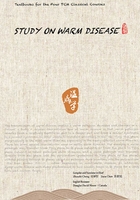
Section 2 Characteristics of Warm Disease
Warm disease possesses the following morbid characteristics.
Different kinds of warm diseases in different seasons are caused by different kinds of warm pathogens, which are stronger in pathogenicity, infectivity and force of mortality than ordinary exogenous pathogens. For example, wind-heat pathogen gives rise to wind warm disease in spring and winter, summer-heat pathogen to summer warm disease in summer, damp-heat pathogen to damp warm disease and latent summer disease in summer, late summer and autumn, and pestilential pathogen to warm pestilence in the four seasons. Moreover, warm pathogens intrude into the body mainly through the nose and mouth besides skin and sweat pores.
The most kinds of warm diseases are featured by different degree of infectiousness, i.e.,the warm diseases, especially pestilence, easily transmits from a patient to the healthy persons. Only a few kinds of warm diseases have no infectivity, e.g., sunstroke and acute leukemia. On the other side, a few kinds of infectious diseases don’t belong to warm diseases, e.g., rabies and schistosomiasis.
Epidemicity refers to how extent of a disease is transmitted unceasingly and spreading extensively in crowd of a big area. Generally, the epidemicity of a disease follows its infectivity, so the majority of warm diseases are epidemic to a certain degree, but a few of them have no epidemicity, e.g., acute leukemia is not epidemic and occurs sporadically,although it belongs to warm disease, and a few epidemic diseases are not warm disease,e.g., simple goiter.
Seasonableness of warm disease denotes most kinds of warm diseases happening in a certain specific seasons. For example, wind-warm happens in spring and winter, summer warm in summer season, damp-warm in the summer and autumn marked with rainingmoist and hot weather, and autumn-dryness in autumn season. This is due to different warm pathogens appearing in different seasons.
Regionalism of warm disease indicates that the majority of warm diseases easily occur and spread in the different regions with geographical features. For instance, damp-warm disease usually occurs in the East-South China, where there is a low terrain with many rivers and lakes and near seas; however, dryness-heat category of warm diseases is often seen in the West-North China, where there are a lot of plateaus and deserts.
The general developing trend of warm disease changes from the exterior to the interior,from the superficial location to the deeper one, and from the excess syndrome to deficiency one. Concretely, warm disease in the early stage mainly manifests the dysfunctions of the human body, i.e., basically pertain to Wei and Qi phases and syndromes of the upper Jiao and middle Jiao; while in the later stage it manifests the consumption of Yin fluid and impairment of some important Zangfu-organs, pertain to Ying and Xue phases and syndromes of the lower Jiao.
The most kinds of warm diseases are characterized by an acute onset, fierce oncoming force, quick development, serious symptoms, multiple transferences and higher death rate.
For example, high fever, skin eruption, bleeding, coma and convulsion are frequently seen in the middle or extremely morbid stage of warm diseases.